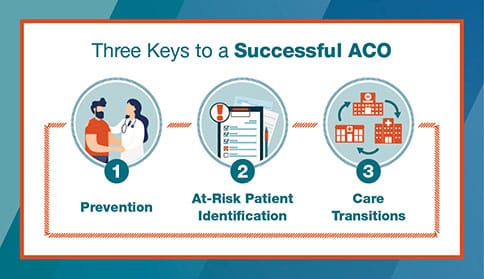3 Keys to a Successful ACO: Your Cheat Sheet
Evolving ACOs and Benefits to Providers
The ACO model has evolved since regulation debut in 2009, and it looks as though ACOs are here to stay. Patients covered by Medicare ACOs rose from 10.5 million in 2018 to 10.9 million in 2019, according to CMS1.
Growth is good, but what about the changes that mandate ACOs take on more risk? Previously, ACOs were rewarded for quality and typically cost savings, and were not held responsible for missing such targets. But a January 2020 redesign of the federal Shared
Savings Program requires ACOs to take on more risk in the form of paying CMS back when they overspend. In exchange for sharing in the risk, ACOs will be rewarded with “higher levels of shared savings and greater regulatory flexibility,”
according to Health Affairs.
ACOs are permitted to shift to the new program over a number of years, but nearly half of new ACOs starting on July 1, 2019, had opted for the downside risk program. And early data suggests the model isn’t as scary as it sounds. ACOs that have taken
accountability for missing cost-savings targets perform better than ACOs still in shared savings-only programs2.
With the coming ACO changes, providers should consider their network partners carefully.
Three Keys to a Successful ACO
Successful ACOs benefit providers, patients and payers. There are three keys to making an ACO successful:

- Prevention. With metrics based on quality and patient outcomes, working with patients to help them stay well is the crux of everything ACOs do. This, of course, is reliant on maintaining good connections with patients as well as being
proactive and consistent with PCP and specialist visits. These efforts and good post-acute partners help ensure that when an acute episode of care occurs, the ACO patient is steered back into preventive pathways by the post-acute setting.
- At-risk patient identification. High-risk patients are the most costly to treat. About 20% of all healthcare expenditures come from the top 1% of the nation’s neediest patients, according to the National Academy of Medicine3.
So in order to control costs, ACOs need to be able to identify their highest-risk patients. They then must assist them with preventive care and offer chronic-disease management to keep them from requiring more costly acute care.
- Care transitions. Every time patients transition from one care setting to another there is the potential that they’ll disengage from the healthcare system or there is a gap in care, putting them at risk for further health problems
and rehospitalizations. ACOs must shepherd patients through such transitions to keep patients actively participating in the preventive care loop and maintaining wellness.
It is important for all members of an ACO to be aware of — and to execute — these success factors for optimal patient and provider benefit, including the acute and post-acute setting participants.
Case Study: Kindred’s Long-Time ACO Experience
Kindred is the LTAC hospital partner of choice for many health systems and ACOs across the country. We are well-versed in the drivers of value-based care and are proven participants in generating ACO savings. We believe that being collaborative and transparent
with our partner ACOs and payers is behind that success.
Kindred is on owner in the Silver State Accountable Care Organization. This strategic partnership created the largest ACO in the market and in the top 20% nationally, with more than 400 physician partners serving approximately 55,000 patients
4.
Kindred has been not only Silver State ACO’s LTAC of choice, but we handled all network and care management for the ACO's first 4 years (2014-2018), helping Silver State ACO consistently generate savings to share with CMS:
- $6.3 million in 2015
- $15 million in 2016
- $15 million in 2017
- $34 million in 2018
To learn more about how Kindred can help your ACO achieve similar shared savings, Contact Us.
References:
- Shared Savings Program Fast Facts – As of July 1, 2019
- More ACOs Taking Accountability Under MSSP Through ‘Pathways To Success’
- Effective Care for High-Need Patients
- Silver State ACO 2018 CMS Data Files